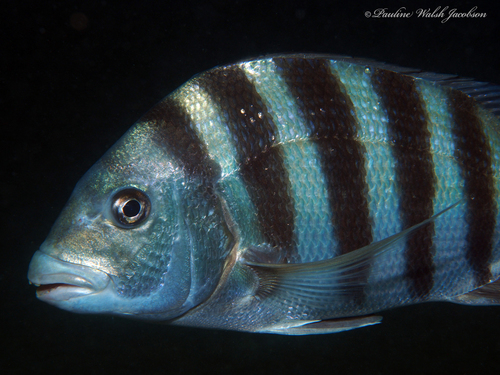
Sheepshead
Bluefin tuna are among the largest and fastest fish in the ocean. Renowned for their size, speed, and powerful swimming ability, they are apex predators and a highly prized catch in fisheries worldwide. They are also crucial to maintaining the balance of marine ecosystems.
7 20 years
Lifespan
up to 91 cm
Length
Least Concern
Conservation Status
Omnivorous
Diet
Local Migration
Migration
Appearance Overview
The Bluefin Tuna has a robust, streamlined body built for speed and endurance.
Color
Dark metallic blue on top, with a silvery-white underside
Fins
Two dorsal fins, the first depressible; small, yellow finlets run down the back and belly to the tail
Body Shape
Torpedo-shaped, with a conical head
Length
Up to 13 feet (4 meters)
Weight
Up to 2,000 lbs (907 kg)
Diet
Carnivorous, feeding on fish, squid, eels, and crustaceans.
Feeding Behavior
Highly active predator that uses its speed and agility to hunt; often hunts cooperatively, herding and trapping prey.
Social Behavior
Forms large schools, especially during migration; known for long-distance migrations across oceans.
Commercial Relevance
Extremely high value, especially in sushi and sashimi markets; one of the most expensive fish in the world.
Conservation measures
International fishing quotas, catch limits, and monitoring programs; efforts to reduce bycatch and improve fishing practices.
Status
Varies by species: Atlantic Bluefin (Endangered), Pacific Bluefin (Vulnerable), Southern Bluefin (Critically Endangered).
Threats
Overfishing (driven by high demand for sushi), bycatch in other fisheries, habitat degradation, and climate change.
Habitat Distribution
Depth Range
0-1,000 meters (0-3,280 feet)
Geographic Range
Atlantic Ocean, Pacific Ocean, Indian Ocean, Mediterranean Sea
Preferred Environment
Temperate and subtropical waters, open ocean, often near continental shelves and slopes
Reproduction and Life Cycle
Breeding Habits
Spawns in warm waters, with major spawning grounds in the Gulf of Mexico and the Mediterranean Sea; spawning is seasonal.
Development Stages
Eggs hatch into larvae, which develop rapidly; juveniles grow quickly, reaching significant size within the first few years.
Fecundity
Females can produce up to 30 million eggs per spawning season.
Maturity Age
Varies by species; Atlantic Bluefin typically mature at 4-8 years, while Southern Bluefin can take longer.
Faqs about Sheepshead
How long do Bluefin Tuna live?
Bluefin tuna can live up to 40 years, though this varies by species and region.
How fast can Bluefin Tuna swim?
They are among the fastest fish, capable of swimming at speeds up to 43 mph (70 km/h).
Are Bluefin Tuna warm-blooded?
Yes, they are warm-blooded, which allows them to maintain a higher body temperature than the surrounding water, aiding in muscle efficiency.
How far do Bluefin Tuna migrate?
They undertake extensive migrations for feeding and spawning, often crossing entire oceans.
Where are Bluefin Tuna found?
They are primarily found in the Atlantic, Pacific, and Indian Oceans, as well as the Mediterranean Sea.
What makes Bluefin Tuna such efficient predators?
Their large size, powerful muscles, and streamlined shape make them apex predators in their environment.
Why are Bluefin Tuna populations declining?
The high demand for their meat in sushi and sashimi dishes, combined with their slow growth and reproductive rates, has led to significant population declines.
What type of environment do Bluefin Tuna prefer?
They are typically found in temperate and subtropical waters, preferring open ocean environments.
Where do Bluefin Tuna spawn?
They spawn in specific areas with warm, clear waters, often returning to the same locations annually.
Copyright @ Nature Style Limited. All Rights Reserved.
 English
English